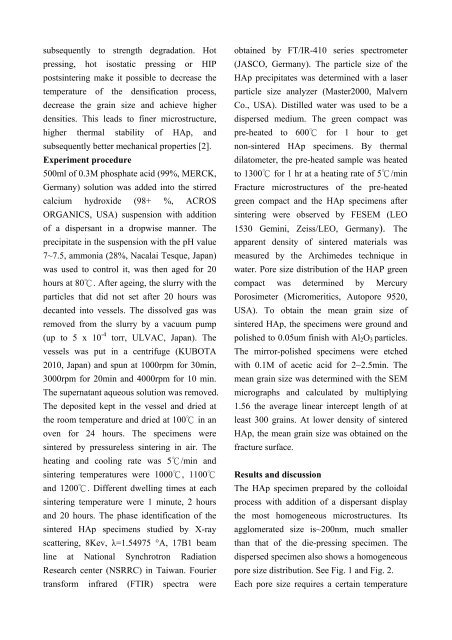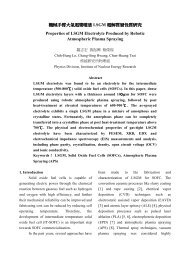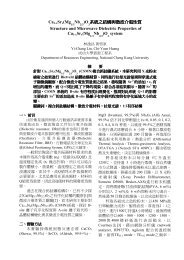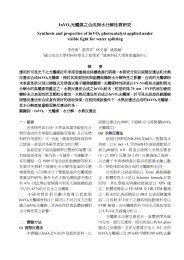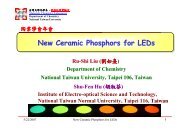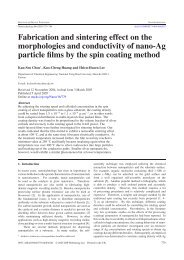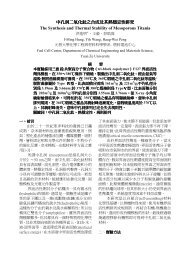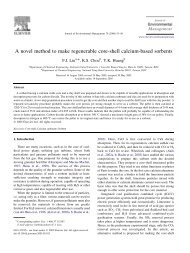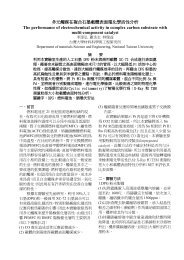Preparation of dense and nano-sized Hydroxyapatite by presureless ...
Preparation of dense and nano-sized Hydroxyapatite by presureless ...
Preparation of dense and nano-sized Hydroxyapatite by presureless ...
You also want an ePaper? Increase the reach of your titles
YUMPU automatically turns print PDFs into web optimized ePapers that Google loves.
subsequently to strength degradation. Hot<br />
pressing, hot isostatic pressing or HIP<br />
postsintering make it possible to decrease the<br />
temperature <strong>of</strong> the densification process,<br />
decrease the grain size <strong>and</strong> achieve higher<br />
densities. This leads to finer microstructure,<br />
higher thermal stability <strong>of</strong> HAp, <strong>and</strong><br />
subsequently better mechanical properties [2].<br />
Experiment procedure<br />
500ml <strong>of</strong> 0.3M phosphate acid (99%, MERCK,<br />
Germany) solution was added into the stirred<br />
calcium hydroxide (98+ %, ACROS<br />
ORGANICS, USA) suspension with addition<br />
<strong>of</strong> a dispersant in a dropwise manner. The<br />
precipitate in the suspension with the pH value<br />
7~7.5, ammonia (28%, Nacalai Tesque, Japan)<br />
was used to control it, was then aged for 20<br />
hours at 80℃. After ageing, the slurry with the<br />
particles that did not set after 20 hours was<br />
decanted into vessels. The dissolved gas was<br />
removed from the slurry <strong>by</strong> a vacuum pump<br />
(up to 5 x 10 -4 torr, ULVAC, Japan). The<br />
vessels was put in a centrifuge (KUBOTA<br />
2010, Japan) <strong>and</strong> spun at 1000rpm for 30min,<br />
3000rpm for 20min <strong>and</strong> 4000rpm for 10 min.<br />
The supernatant aqueous solution was removed.<br />
The deposited kept in the vessel <strong>and</strong> dried at<br />
the room temperature <strong>and</strong> dried at 100 ℃ in an<br />
oven for 24 hours. The specimens were<br />
sintered <strong>by</strong> pressureless sintering in air. The<br />
heating <strong>and</strong> cooling rate was 5 ℃ /min <strong>and</strong><br />
sintering temperatures were 1000 ℃ , 1100 ℃<br />
<strong>and</strong> 1200 ℃ . Different dwelling times at each<br />
sintering temperature were 1 minute, 2 hours<br />
<strong>and</strong> 20 hours. The phase identification <strong>of</strong> the<br />
sintered HAp specimens studied <strong>by</strong> X-ray<br />
scattering, 8Kev, λ=1.54975 °A, 17B1 beam<br />
line at National Synchrotron Radiation<br />
Research center (NSRRC) in Taiwan. Fourier<br />
transform infrared (FTIR) spectra were<br />
obtained <strong>by</strong> FT/IR-410 series spectrometer<br />
(JASCO, Germany). The particle size <strong>of</strong> the<br />
HAp precipitates was determined with a laser<br />
particle size analyzer (Master2000, Malvern<br />
Co., USA). Distilled water was used to be a<br />
dispersed medium. The green compact was<br />
pre-heated to 600 ℃ for 1 hour<br />
to get<br />
non-sintered HAp specimens. By thermal<br />
dilatometer, the pre-heated sample was heated<br />
to 1300℃ for 1 hr at a heating rate <strong>of</strong> 5 ℃ /min<br />
Fracture microstructures <strong>of</strong> the pre-heated<br />
green compact <strong>and</strong> the HAp specimens after<br />
sintering were observed <strong>by</strong> FESEM (LEO<br />
1530 Gemini, Zeiss/LEO, Germany). The<br />
apparent density <strong>of</strong> sintered materials was<br />
measured <strong>by</strong> the Archimedes technique in<br />
water. Pore size distribution <strong>of</strong> the HAP green<br />
compact was determined <strong>by</strong> Mercury<br />
Porosimeter (Micromeritics, Autopore 9520,<br />
USA). To obtain the mean grain size <strong>of</strong><br />
sintered HAp, the specimens were ground <strong>and</strong><br />
polished to 0.05um finish with Al2O3 particles.<br />
The mirror-polished specimens were etched<br />
with 0.1M <strong>of</strong> acetic acid for 2~2.5min. The<br />
mean grain size was determined with the SEM<br />
micrographs <strong>and</strong> calculated <strong>by</strong> multiplying<br />
1.56 the average linear intercept length <strong>of</strong> at<br />
least 300 grains. At lower density <strong>of</strong> sintered<br />
HAp, the mean grain size was obtained on the<br />
fracture surface.<br />
Results <strong>and</strong> discussion<br />
The HAp specimen prepared <strong>by</strong> the colloidal<br />
process with addition <strong>of</strong> a dispersant display<br />
the most homogeneous microstructures. Its<br />
agglomerated size is~200nm, much smaller<br />
than that <strong>of</strong> the die-pressing specimen. The<br />
dispersed specimen also shows a homogeneous<br />
pore size distribution. See Fig. 1 <strong>and</strong> Fig. 2.<br />
Each pore size requires a certain temperature


